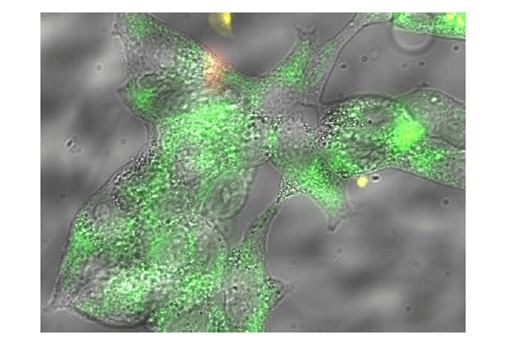An advanced molecular structure may detect and report intracellular activity that may cause cancer

Molecular detectors are increasingly used to study the activity of proteins and for identifications in a biological environment (such as living cells and body fluids). This is how these detectors contribute to the diagnosis of diseases (for example, those caused by damaged proteins), which may help in the development of inhibitory drugs. Prof. David (Didi) Margolis from the Department of Organic Chemistry at the Weizmann Institute of Science, and his team, build such detectors from fluorescent synthetic molecules that bind to proteins, which allows them to be identified. When these detectors are inserted into a living cell, they hit the target protein (because they are composed of molecules intended for this), light up and glow; Because, as a result of the damage to the protein, the chemical environment of the detectors changes their optical properties.
Prof. Margolis and his team read the signals emitted by these detectors using fluorescence microscopy methods. This method may have several main uses: basic research, identification of the protein's location in the cell and its quantity, medical diagnosis (detection of a protein that is a disease marker, for example in body fluids such as blood and urine), and future development of drugs that inhibit disease-causing proteins.
"The detector", says Prof. Margolis, collides with the problematic protein in its target area, which is essential for it, as drugs do. In addition, today there are libraries of hundreds of thousands of molecules from which it is possible to find molecules that damage disease-causing proteins and inhibit their activity (that is, potential drugs). Thus, if we introduce into a living cell a detector and an inhibitory molecule - the detector will turn off when it hits the target protein and that's how we know it is effective (it will turn off because the molecule takes its place in the target area of the protein and pulls it out)".
One of the interesting developments of Prof. Margolis and his team is a detector that acts as a "molecular nose", which can detect many proteins in a living cell at the same time and shine in a rainbow of colors. "While most chemical detectors consist of a specific receptor for one molecule," says Prof. Margolis, "and a transmitter that translates the binding into an optical or electrical signal, this detector consists of an array of receptors and transmitters that can bind to different molecules at the same time. This is how he identifies a variety of substances, from counterfeit drugs to the compositions of protein aggregates that exist in the brains of Alzheimer's patients."
In their latest study, which won a research grant from the National Science Foundation, the researchers wanted to identify an interaction between proteins in living cells and therefore built a fluorescent detector that can detect it. Prof. Margolis says: "Today, many interactions between proteins within living cells are known that lead to diseases such as cancer, so it is important to identify them and develop drugs to delay them. At this stage, there are no methods good enough to do this, and our goal is to improve our ability in this area." One of the known interactions between proteins is the one between growth factor receptors in cancer cells and the growth factors themselves, which are outside the cells. Growth factors are of crucial importance in the development of cancer as they stimulate the division and differentiation of cells and help the cancer cells to grow blood vessels that feed them.
The researchers exposed cancer cells to a detector they developed, which can bind to the PDGF growth factor receptor. The detector is designed so that when it encounters a receptor, it binds to it and shines - and in this way reports the finding. The binding of the growth factor to the receptor changes the chemical environment of the detector and turns off its light - which makes it possible to identify the interaction between them. The researchers hope that based on these findings it will be possible to identify molecules that will prevent this interaction and lead to the development of new anti-cancer drugs.

The seas themselves:
Prof. David (Didi) Margolis, 47 years old, father of three children, lives in Rehovot. likes to run, swim and cook.
More of the topic in Hayadan:
- Scientists at the Weizmann Institute of Science inserted a miniature "nose" into a living cell
- The great Israeli contribution to the discovery of the small particle
- The winners of the 2005 Wolf Prizes in Physics and Mathematics have been selected
- Wearable detectors for detecting dangerous gases
- A new detector will determine the origin of gravitational waves
